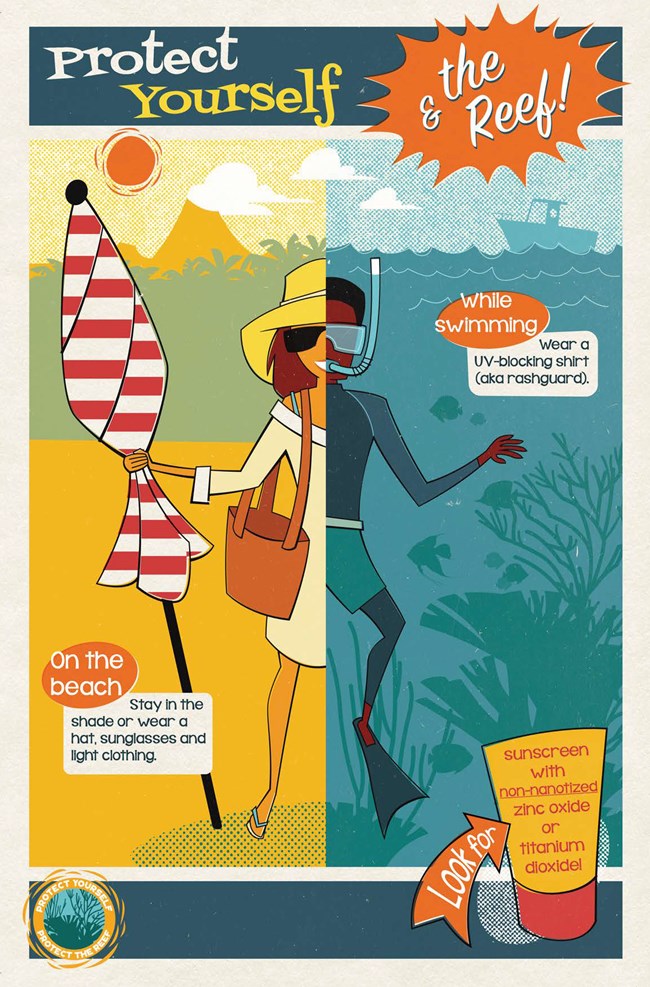
Did you know that many chemicals found in sunscreens are harmful to coral reefs and ocean life? It is estimated that every year 4,000 to 6,000 tons of sunscreen wash off swimmers into oceans worldwide and that ten percent of coral reefs are threatened by sunscreen-induced bleaching. Help protect yourself and protect the reef by always choosing reef-friendly sun protection. On this page, learn what chemicals are harmful, why they are harmful, how to choose reef-friendly sun protection, and find external resources for more information. Harmful Sunscreen ChemicalsThe State of Hawaiʻi was the first state in the nation to ban the sale of sunscreens with chemicals harmful to ocean corals. The law went into effect January 1, 2021, but some harmful products are still available. Please do your part to protect our ocean's coral reefs by not using sunscreens with the following chemicals: Not going swimming? Don’t live near the ocean? It is still important to make the choice to use reef-friendly sunscreens. Everything in our global ecosystem is connected. When you rinse your sunscreen off in the shower, once it goes down the drain, do you know where it goes? Unfortunately, it is likely to ultimately end up in our groundwater or freshwater streams. And where do those streams lead… to the ocean! Effects in the OceansThe National Park Service and research organizations around the world conduct water sampling in our world’s oceans. High concentrations of chemicals found in sunscreens, such as oxybenzone and avobenzone, have been found in the waters surrounding coral reefs as a result of sunscreen washing off swimmers and ocean recreators. Research is showing that these chemicals can harm coral health and reproduction, potentially contributing to the decline of coral reefs. Healthy vs. Unhealthy Coral 

Left image
Right image
But the effects of chemical-based sunscreens don’t stop with corals. The coral reef ecosystem is a diverse and dynamic environment. When one part of the coral reef environment is harmed, the entire ecosystem is affected. For example, sunscreen chemicals can affect the growth and photosynthesis in green algae and seaweeds. These are primary food sources for our beloved honu (Hawaiian green sea turtles) so, due to chemical-based sunscreen, our honu are even more threatened. 
Infographic: NOAA Infographic is divided into 4 sections: How sunscreen chemicals enter our environment, how sunscreen chemicals can affect our marine life, chemicals in susncreens that can harm amrine life, and how we can protect ourselves and marine life. Graphics depict what text is saying. Transcript is as follows:

How to Choose Reef-Friendly Sun ProtectionWith confusing chemical names and “green washing” (companies claiming their sunscreens are reef-friendly or reef-safe, when they really aren’t) choosing reef-friendly sun protection can be a difficult task, but we’re here to help! Infographic poster showing how to protect yourself and the reef while swimming and on the beach. Title reads: Protect Yourself & the Reef! Image is split into two halves. The left half shows a tropical beach background with beach, sun, volcano, and palm trees. The image shows the left half of a woman holding a beach umbrella and has a bag over her shoulder. She is wearing a large sun hat, sunglasses, light-colored dress, and sandals. Text reads: On the beach, Stay in the shade or wear a hat, sunglasses, and light clothing. The right half shows an underwater ocean background with a boat on the ocean's surface and corals and fish below the surface. The images shows the right hald of a man in snorkeling gear (goggles, mask, and fins). He is wearing a rashguard, swimsuit, and tightly fitting leggings. Text reads: While swimming, Wear a UV-blocking shirt (aka rashguard). The bottom border has the Protect Yourself, Protect the Reef circular logo with blue corals in the center, a yellow-orange border with "Protect Yourself, Protect the Reef." The lower right corner has an image of a sunscreen bottle with arrow pointing to it. Text on arrow reads: Look for. Text on sunscreen bottle reads: sunscreen with non-nanotized (underlined) zinc oxide or titanium dioxide!
How to Dispose of Environmentally Unsafe SunscreensHave environmentally unsafe, chemical-based sunscreen? It’s important that you dispose of them properly so that those harmful chemicals don’t ultimately make their way into the oceans. If you are visiting Hawaiʻi or live on the island, there are places where you can drop off your environmentally unsafe sunscreens. Local non-profit, The Kohala Center, works in partnership with the County of Hawaiʻi to dispose of these sunscreens in an environmentally friendly way. There are drop off locations in Kailua-Kona, Waimea, Hāwī, and Hilo. 
Icon of person holding up their right hand with green speech bubble that says the Honu Pledge: I promise to mālama nā honu (care for sea turtles). I will kōkua (help) by: Staying 20 feet (6.5 m) away in the water and on shore, Reducing my use of plastics, Always using reef-friendly sun protection, and sharing my ʻike (knowledge) with others. Below is an image of the Honu Pledge Sticker with text: Don't forget your sticker! Help protect sea turtles by taking the Honu Pledge. 1. Raise your right hand and repeat the pledge above. 2. Stop by the Kaloko-Honokōhau NHP visitor center for your Honu Pledge sticker to help share your ʻike with others.
More ResourcesNational Ocean and Atmospheric Administration (NOAA) – Skincare Chemicals and Coral Reefs |
Last updated: March 3, 2022
